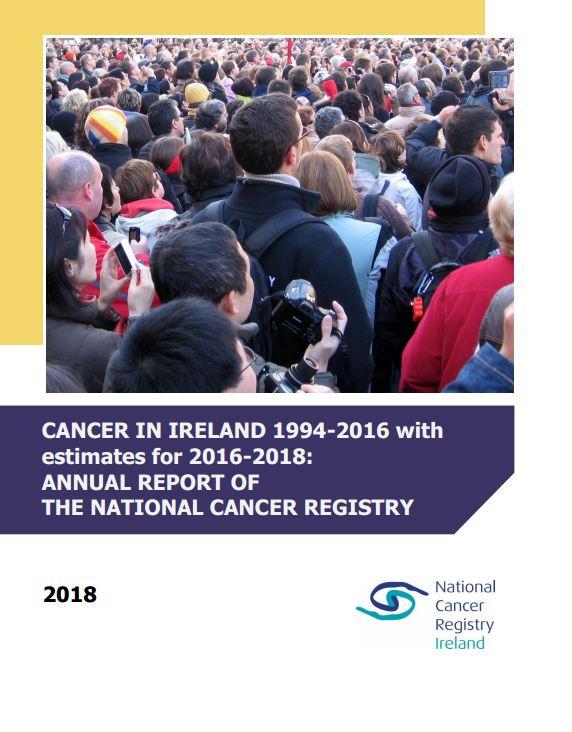Cancer in Ireland 1994-2016 with estimates for 2016-2018: Annual Report of the National Cancer Registry
Ongoing and projected further increases in cancer cases reflecting population growth and ageing: latest report from the National Cancer Registry

- Based on the latest available information, it was estimated that 33,460 invasive cancers, or 22,640 cancers excluding the generally non-fatal non-melanoma cancers of skin, were diagnosed annually during 2016-2018 (or 41,080 cancers or other registered, non-invasive tumours). The risk of developing cancer was higher for men than for women, overall and for most cancer types. Non-melanoma skin cancer, prostate cancer and breast cancer were the most commonly diagnosed cancers.
- Total numbers of cancers diagnosed annually have increased by about 85% since the mid-1990s, largely reflecting population growth and ageing.
- Cancer incidence projections based on an assumption that recent (2011-2015) cancer rates continue to apply in future suggest a further potential doubling of annual case numbers between 2015 and 2045. However, the overall increase by 2045 could be a more modest 50% increase if recent trends, including declines, in rates of some cancers continue.
- Cancers and related tumours are now the most common cause of death in Ireland (just ahead of diseases of the circulatory system), and an annual average of about 8,875 deaths from invasive cancer (or 9,094 deaths from all tumours) occurred during 2013-2015. Lung cancer was the leading cause of cancer death in both sexes, accounting for 19% of cancer deaths in women and 23% in men. The risk of dying of cancer was about 34% higher for men than for women.
- Nevertheless, survival has improved markedly for cancers as a whole and for the most common cancer types since the mid-1990s. For invasive cancers (excluding generally less serious NMSC), overall five-year net survival increased from 40% for males during 1994-1998 to 62% during 2010-2014; in females, five-year net survival increased from 48% during 1994-1998 to 60% during 2010-2014.
- Reflecting ongoing increases in numbers of cases diagnosed and in survival, a total of about 173,000 cancer survivors (previously diagnosed with an invasive cancer other than non-melanoma skin cancer) were estimated to be alive at the end of 2016 (equivalent to 3.7% of the Irish population). The top four most common cancers represented among the surviving (prevalent) cancer patient population were: breast cancer (23% of all cancer survivors), prostate cancer (20%), colorectal cancer (12%) and skin melanoma (7%).
- Updated figures on emergency presentations by cancer patients are presented. Overall during 2014-2016, 14% of cancer cases (excluding non-melanoma skin cancers) presented as emergencies at the time of diagnosis, excluding cases where the mode of presentation was unknown. Major cancers with the highest proportions of emergency presentation during 2014-2016 were cancers of the pancreas (36%), liver (34%), brain & CNS (31%) and lung (25%).
Share this page